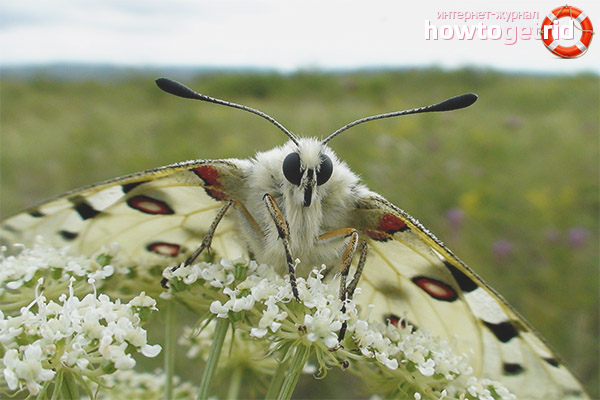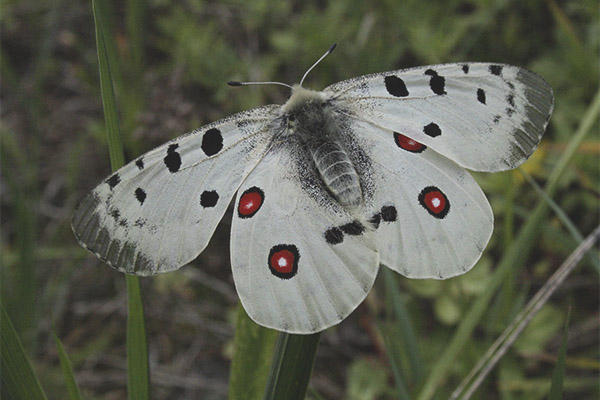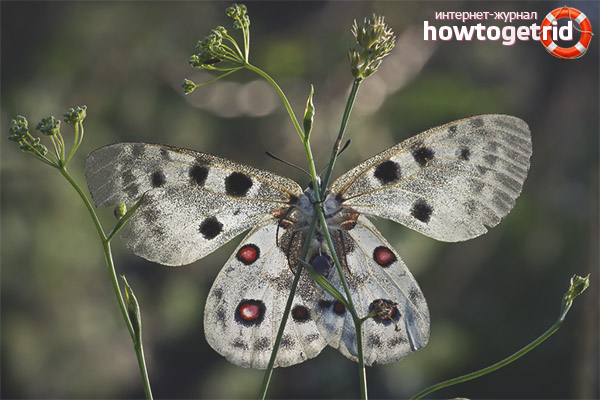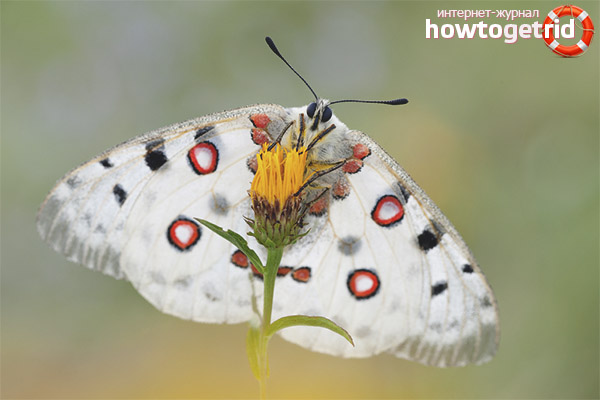The content of the article
Apollo butterfly belongs to the family of sailboats. It is one of the most beautiful diurnal butterflies in Europe. Many collectors dream to get such a copy. The insect got its name precisely because of the beauty of its wings. Currently, there are about 600 subspecies, which is very attractive naturalists. The biology of many subspecies has not yet been studied.
Appearance
The wings are white, beige or cream in color, the edges are transparent. The approximate length of the front wings is 4 cm. On each rear wing there is a red or orange speck in a black circle with a white center. Males have a bit smaller patterns than females.
The wingspan is from 7 to 9 cm. There are short white antennae with black ends on the head. They are the main body of touch and help the butterfly navigate.
Large black eyes. Thin, short beige-colored legs have barely noticeable villi. Short hairs also grow on the abdomen.
Before the transformation, the caterpillar has a black color with white patches. There are small tufts of hair all over the body. Older caterpillars reach 5 cm in length. They have dark blue warts on each side one by one, as well as 2 red specks, one slightly wider than the other.
Habitat
Apollo prefers highlands, valleys at an altitude of 2 km and above. Habitat area is very wide. Individuals can be found in many places. The most common butterfly is found in the following countries:
- Russia;
- Spain;
- Norway;
- Sweden;
- Finland;
- Mongolia.
Apollo can be seen in the Alps, and some species are adapted to life in the Himalayas. A butterfly settles in a pine forest near mountain rivers. It can also be found in deciduous or coniferous forest on the edge.
Demeanor and lifestyle
Apollo can be found in the summer. This species prefers to live daytime life, and at night to sleep in the tall grass. If the butterfly senses danger, it flies away immediately.However, it flies, surprisingly, weakly and awkwardly. Although when searching for food she is able to overcome about 5 km.
Birds do not hunt Apollo butterfly due to deceptive coloring. Red spots seem to indicate that the insect is poisonous (it is not), and predators avoid contact with the butterfly. In addition, Apollo rubs his paws together, producing creaking sounds that frighten birds even more.
Number of

Most species of butterflies, one way or another, belong to the category of endangered species. The same can be said about Apollo. In the habitats there are many individuals, but they are caught in large quantities. Because of this, this species faces complete extinction. Poachers and collectors are attracted by the beauty of their wings. In the last century, the Apollo butterfly almost completely disappeared in most of the regions of Russia that it inhabited. In Europe and Asia, the insect numbers are markedly reduced.
In addition, the anthropogenic factor carries a great danger to the abundance of this species. Man destroys feeding areas, and individuals have nothing to eat. Apollo is also very sensitive to the sun's rays, from which he takes cover in the grass.
In most countries where the Apollo butterfly lives, this species is listed in the Red Book. At the moment, biologists are trying with all their might to prevent the complete disappearance of the insect. Nurseries are being created, the number of feeding areas is increasing. However, all of the above measures have not yet brought a serious result.
Currently, in some regions of Russia, where a large number of Apollo individuals used to live, it is rare to find this butterfly. In the world of zoology, periodically there is news that the insect of this species has been seen in different areas. The case immediately take control of biologists. They study the species, contribute to its reproduction and increase the population.
Diet
Caterpillars are very voracious. As soon as they are born, they immediately begin to feed. Powerful jaws gnaw all new and new leaves. If the caterpillar does not find foliage, it can eat small insects and their larvae.
After becoming a butterfly, Apollo, like all insects of this species, feeds on floral nectar. For this he has a spiral proboscis,which in the process of feeding unwinds and straightens straight.
Breeding method
The Apollo butterfly breeds in summer. Females lay hundreds of small eggs on the leaves. They are all round, with a diameter of 2 mm. Hatching occurs in April - June. The color of the larvae is black with orange dots throughout the body.
After hatching, the process of active feeding begins immediately. This is due to the future transformation, it will take a lot of energy to implement it. Constantly feeding, they increase body weight, while the shell is getting thinner.
Later, Apollo begins to moult, which repeats 5 times. Then, when the caterpillar has grown enough, it falls to the ground and becomes a pupa. This process will take about two months. The caterpillar in a cocoon does not move and does not show signs of life. After that, it turns into a beautiful butterfly. As soon as the wings dry, the insect begins to look for food.
Apollo lives 2 summer seasons. Before winter, the female lays eggs, from which the larvae hatch in summer. After significant changes, a beautiful butterfly appears that pleases the eye when meeting it.
Subspecies and their distinctive features
Apollo butterfly has about 600 species. The fact is that it has a wide geography. Naturalists have identified some pattern: depending on the climatic conditions, the color of Apollo changes. In each region, the butterfly has an individual color, the location of spots, etc. The entomologists (scientists who study insects) have a lot of controversy because of this. They can be divided into 2 groups:
- It is believed that due to the distinctive features in the appearance of many individuals, one can distinguish the subspecies.
- Deny any subspecies, despite the differences.
Apollo butterfly is not fully understood. Perhaps the list of subspecies will be updated.
Black Apollo (Mnemosyne)
The wingspan is 5-6 cm. Unlike the simple Apollo, Mnemosyne has no red spots, and the edges of the wings are more transparent. Veins on the wings are pronounced. On each top wing there are 2 black spots. The body is black.
Apollo Arctic (Apollon Ammosova)
The wingspan is even smaller - it does not exceed 4 cm. In males, wings are white in color, in females - gray due to abundant fluffy cover.On the upper wings 3 small spots. There are individuals with a red spot on the lower wing and without it. Apollo Arctic is often found in the northern regions of Russia. It can tolerate low temperatures, in comparison with the endurance of other subspecies of Apollo. It is difficult for him to find food, as there are no abundant vegetation in the territory of residence. Sometimes it migrates to larch deposits for mating. Biological data about Apollo Ammosov virtually none.
Apollo Nordmann
This subspecies can be found only in the alpine belt of the Greater and Lesser Caucasus. The butterfly received its name in honor of the Russian zoologist, who made a great contribution to the study of the fauna of the Caucasus. Distinguishes Apollo Nordmann from other subspecies larger size.
Interesting Facts
- The butterfly received its name in honor of the Greek sun god Apollo. The beauty of the wings inspired biologists so much that they christened the insect by such a magnificent name.
- Surprisingly, this species has a bad flying ability. When danger approaches, she tries to fly away as soon as possible. However, this is not always possible to do.In this case, Apollo spreads its wings and begins to rub his paws on them. A hissing sound is created that scares the predators.
- Apollo butterfly prefers mountain areas, which is not typical for insects. This species is well adapted to low temperatures. In addition, the insect can be found at high altitude. For example, high-mountain species live in the Himalayas and feel great at an altitude of 6 km from sea level.
- The Apollo Arctic subspecies lives near an area where snow never melts. For such a fragile insect is a real miracle.
Video: Apollo butterfly (Parnassius apollo)













To send